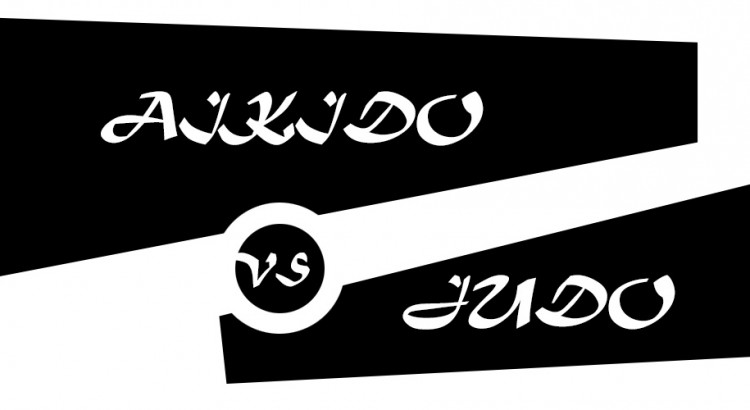Aikido and Judo are two of the most famous Japanese martial arts in the world today, rivaled only by the likes of Karate and traditional Jiu Jitsu (Jujutsu). Both revolve around tackling, throwing, and getting the opponent on the ground instead of striking with punches and kicks.
Similarities in Appearance
Many of the moves and techniques look the same to people who have never studied either of the two arts. Even their uniforms look the same – differentiating an Aikido gi from a Judo gi isn’t easy for the untrained eye.
The belt system differs from school to school, especially in the west, however in Japan both Aikido belts and Judo belts are given in just two colors: white and black. This makes it even harder to identify which school of fighting a person is practicing.
Similarities in Heritage
Both arts are descendants of ancient Jujutsu techniques so in many ways they look and may even feel somewhat the same. Both Aikido and Judo owe a lot of their philosophies, techniques, and styles to the ancient Jujutsu arts that were practiced by the samurai.
Jujutsu is a collective term for a myriad of ancient fighting arts but all of them focused on one goal: combat styles that a samurai could use during war when they were not in reach of their sword.
The sword was the samurai’s main weapon but in the chance they lose it they should still be able to fight and defeat their enemy. Many Jujutsu styles focused on disarming the opponent, injuring the opponent, and even killing the opponent.
Diversion in History
Judo was formed by Jigoro Kano during 1882 and it fully blossomed during the 1900s. It was the first school of martial arts that used a gi and belt as a uniform and it was the first that focused primarily on competitive sports instead of street combats and war.
Judo takes most of its inspirations from Tenjin Shinyo Ryu as well as Kito Ryu. This turned Judo into a form of Jujutsu that formed on grapples, chokes, and submissions.
Jigoro Kano also befriended Gichen Funakoshi who was the progenitor of Shotokan Karate. He later applied Shotokan striking techniques (known in Judo as Atemi Waza) into his own martial art although these are only taught to black belt Judo students.
Aikido was formed by Morihei Ueshiba during the 1930s and 1940s. He realized that many Jujutsu schools were making their students rude and violent. They only focused on techniques that were commonly used for war and this caused students and others to get injured.
Ueshiba, inspired by the techniques of Daito-Ryu-Aiki-Jutsu (which is also applied in Judo), and integrated a system of philosophy that would later form the art of Aikido.
Aikido’s philosophy focused on martial arts solely for self-defense and that it was a way of life emphasizing on discipline and the desire to cause no harm to others. Aikido is designed to take down an opponent in self-defense but also to make sure that the opponent is not seriously injured.
Difference in Style
Here’s where the two show their differences. Judo is focused entirely on aggressive takedowns and submissions. Practice involves sparring against an opponent doing everything they can to win, allowing their students to put all their skills and knowledge to the test.
This is what made Judo such a popular sport. It’s a sport so it isn’t designed for war but it is still aggressive enough to be used for self-defense and entertainment. A skilled Judo fighter can easily lock and break a person’s joints with the right position and movements.
Aikido uses a much different strategy. It also uses grabs and takedowns but the main focus is to use the enemy’s force and weight against him in order to throw them down and incapacitate them from fighting any further.
This is why Aikido is taught for self-defense instead of focusing as a competitive sport. Women and children can easily learn apply the techniques of Aikido. Shorter men and even people with generally weaker bodies can throw down a much bigger opponent using Aikido.
Judo is a ground-fighting technique where the combatants are struggling to submit each other using joint locks, chokes, and others. Aikido is done standing and the fight stops once one opponent throws down the other.
Both use striking movements but only for measuring distance, distraction, defense, and evasive maneuvers.
Which is More Practical?
Both martial arts are practical for use in the real world but it all depends on preference, body stature, and the circumstances to determine which is better.
A slender woman assaulted by a rapist in an alley would do much better with Aikido. They can use the momentum of their attacker’s strikes to grab them, throw them down, and then run away to safety.
A woman trapped in a small room and is being held at knife-point will be apply to Judo techniques to change positions so that she will have the upper hand. This will allow her to free herself from her captive’s hold and then subdue the attacker with a powerful joint lock or choke.

Enjoyed every bit of your blog.Really thank you! Want more.